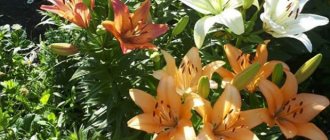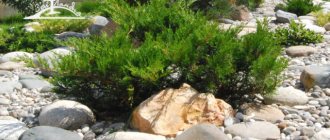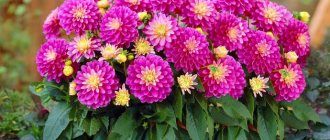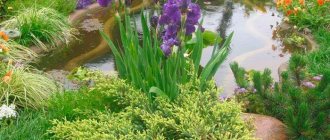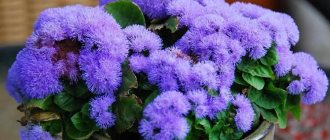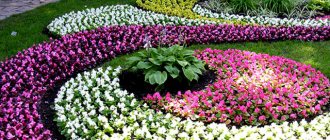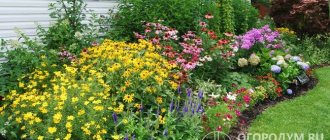Hosta is so unpretentious that growing it is a pleasure. It looks great both in single plantings and in combination with many ornamental crops. There are a lot of varieties of this plant, so every gardener can easily choose the one they need for landscaping their garden plot. Read on for information on options for placing hosta in the garden: in a flowerbed, in a border or under trees.
Hosta. (Photo used under standard license ©ogorodnye-shpargalki.ru)
What is the best thing to combine hosta with when planting?
Many plants can be planted next to hostas, but there is a nuance (besides the obvious - the coincidence of requirements for living conditions). Don’t forget to immediately check what size the host will reach when it grows up - the leaf span of an adult plant can be very, very significant. Here's an example of one of my own long-standing missteps:
Everything is fine, but the primrose is planted too close to the host. At that time, I didn’t take into account that as the hosta grew, it would cover all the free space between two astilbes (by the way, they are wonderful neighbors). The primrose had to be replanted. Therefore, relatively small plants such as lungworts, primroses, daisies and others should be planted at some distance. In the summer it all looked like this (the hosta is still young - with age it has become much larger):
But small-bulbous plants (muscari, chionodoxa, pushkinia, scillas, crocuses and others), as well as daffodils (that is, everything that does not require annual digging - tulips will not work) can be planted closely: when they bloom, the hosts are not yet visible , and by summer its powerful leaves will cover the unsightly “bald spots” in place of the withered foliage of the bulbous plants. And here is an option where late muscari grow next to compact “blue” hostas:
White sedum spreads under them (both it and various forms of false sedum are excellent neighbors for hostas)
In the background is Byzantine chist, which also sits well next to the hostas. For example, like this:
Hostas and cypress spurge look good next to each other (just be careful that it doesn’t grow too much)
Here are the hostas in the shade of the ferns; on the side - variegated sedge (in any case, that’s what the neighbor who shared it with me called this plant), perhaps experts will clarify the name):
Combinations of hosta with ground cover plants are very successful (both wild ones, such as ivy bud, and cultivated plants, such as sedums, periwinkles, and others, are also suitable). In general, even the entire seven-dacha community probably won’t be able to compile a complete list of everything that can be planted next to hostas))) There are a lot of options!
Exactly, there are many combinations with hosta. The main thing is that there is a contrast then it’s beautiful. That is, the leaves of the hosta are oval or rounded and whole, which means we plant a leaf with the opposite shape next to it (cut-leaved or openwork). The main thing is not to forget that the leaves of the hosta are very dense and good rain is needed for the water to reach the roots of the hosta. Especially the blue giants.
Here in the photo of the host is a blue giant, and next to it is a kitten. You can see for yourself that nothing grows nearby. And this hosta is still a baby, she is 2 years old. It will increase a little more.
Ferns grew next to the hosta, but I had to move them and will move them again.
And here’s what I wrote about: the contrast of leaf shape and color
In general, the hosta is considered a universal “garden decorator”. Purely in form, most plants are compatible with it. Only, of course, not those who prefer open sun. That is, they will look good next to each other, but the host herself will suffer. And also - depending on the size of the hosta. There are very large hostas, with huge leaves, next to them only tall lilies, delphiniums, phlox, daylilies, onions, ferns, rhododendrons and similar plants will look good and will not suffer from it. The main thing is that the hosta companions are not undersized - otherwise it will cover them over time, even if the variety is relatively small. Sometimes, in any case, you have to tear off some of the leaves of the hosta from time to time so that it does not step on neighboring plants. By the way, you can staple a very beautiful tablecloth from torn hosta leaves - for one day, of course, but suddenly you are expecting guests, and this will be an original accessory.
Lilies and hostas
This very successful combination is especially loved by landscape designers. Hostas cover unsightly lily stems with their large leaves. They grow quite slowly and do not cause gardeners problems with weeding, and the large leaves of one bush can cover an entire square meter of area around the lilies. To prevent the soil in the flowerbed from being empty in the spring, because hostas wake up quite late, plant bulbs of snowdrops, muscari or crocuses on it. They do not bloom for long, so the hosta leaves that grow in summer will not disturb them. With a minimum of effort put in at the very beginning, such a flowerbed will look well-groomed and decorative for many years. As they say, plant it and forget it.
Hostas in the garden - landscape tricks
A well-groomed garden and the facade in front of the house is the dream of many gardeners. To implement it, you need to start with landscape work. Hostas are considered the most popular used for decorating not only garden plots, but also park areas. These decorative herbaceous perennial plants are so popular and irreplaceable that it is impossible to imagine a single nook of the garden without them.
Hosta was previously called funkia; its main places of growth were China, Korea, and the Far East. The variety of herbaceous perennial includes more than 60 species of hosta, it is known in all corners of the globe. Why is it attractive? The leaves and their color are the main decoration of the hosta. In the garden, the landscape tricks of the designers are manifested in its harmonious juxtaposition with many beautifully flowering plants and tall cereals.
There are many varieties of hosta. Even classic perennial bushes with green leaves are not the same. The drawings on them have dark and light colors. Borders, stripes, white streaks in various variations create unique combinations on the leaves, changing the appearance of the plant.
Astilbe
The culture has apical inflorescences that are covered with flowers of different shades. When they fade, they do not lose their attractiveness. Astilbe leaves are pinnately dissected and grow on long petioles, so they are excellent for proximity to large hosta leaf blades.
Both types of plants are unpretentious, love shade, moisture, and easily tolerate severe frosts if there is a layer of snow on them.
How to plant hostas beautifully
The most unpretentious of the plants that are planted on a personal plot or in a garden is considered to be the hosta. It grows even in the most shaded areas. Many of its varieties thrive both in sunlit areas and in corners of the garden with diffused but bright light.
Variety of hosta species
Flower growers recommend determining the best place to place the hosta by planting it in different parts of the garden. Next year it will become clear in which of the selected areas the plant feels better. This can be determined by the color of the foliage. Next, you can transplant the grown bush to the chosen location. The perennial is unpretentious in care and tolerates changes in habitat painlessly. If necessary, hosta can be grown in a container for the purpose of landscaping balconies and terraces.
Advice. It is better to grow a perennial plant by dividing the rhizomes. Experienced florists believe that this method is more convenient than growing hostas from seeds.
Planting this herbaceous plant in carpet design looks beautiful. Its large leaves prevent weeds from growing in the garden. Carpeting in this case is considered not only decorative, but also useful.
Neighborhood with conifers and juniper
Flowerbed without weeding
The need to regularly weed around lilies often forces gardeners to refuse to plant lilies on their plots. Coarse weeds quickly clog the tender shoots of lilies, and they soon stop growing altogether.
We suggest making flowerbeds of lilies with your own hands (photo presented in the article), among plantings of rhododendrons and astilbes.
A large flowerbed in the middle of the garden, on which these large plants flaunt, will harmoniously perceive the neighborhood with lilies. Astilbe takes root quite deeply, so in a short time it quickly and forever displaces all the weeds that previously grew in this place. In such conditions, lily bulbs will feel absolutely excellent. Lush rhododendrons will distract attention from the unsightly stems of lilies, and the flowers of the lilies themselves against the background of the waxy leaves of rhododendrons will look especially noble.
If the appearance of bare soil seems dull and uninteresting, then it can be covered with a layer of well-dried and crushed tree bark.
What to plant next to hostas
What does hosta go with in a flowerbed? These ornamental plants get along well with all flowers, so the question of what to plant next to the hosta does not arise. Previously, this perennial plant could rarely be found in flower beds and flower beds. It was considered something special among the usual plants and flowers. Modern varieties decorate flower beds and paths. They look wonderful surrounded by roses, peonies, hydrangeas, and irises. A good tandem of hostas in a flower bed with geraniums. These plants are a decoration for any flower garden: from a ceremonial composition to a shady corner in a landscape style.
Is it possible to plant roses between thujas along the fence?
Photo source - davesgarden.com, rose variety - "Iceberg". An example of a very beautiful successful combination of roses and thujas along the fence.
First of all, the rule is that coniferous trees should be planted at a distance of 1.5 meters from the fence, since when they grow, they can damage the installed fence. Developing a composition where thujas and roses are combined looks very beautiful, but requires constant care. Plants must be pruned in a timely manner and their growth monitored.
Hosta in landscape design
Designers use a variety of hosta varieties in their compositions. They are attractive because they tolerate low temperatures well, are frost-resistant, which means they are a perennial decoration. These perennials are divided into varieties with original glossy, waxy and matte leaf coating. There are varieties with very large leaves, and these ornamental plants also have small leaves. The type of leaf is also varied. Its structure can be smooth, embossed, wrinkled and with wavy leaves.
Interesting. There are miniature varieties of perennials, the height of which is just over 10-15 cm. They appeared in the last decade and have taken root in home floriculture. Subspecies of hosta varieties are used in garden landscapes.
It all depends on the height of the herbaceous perennials. Ground cover - have a height of up to 20 cm, border - from 20 to 30 cm, medium-height - 30-45 cm and high - from 45 to 80 cm. With their help, you can, using optical illusion, revive the darkest corners of the garden, creating multi-tiered compositions.
Hosta in the flower garden
Thanks to the beauty of their leaves, herbaceous bushes are not only a decoration for gardens. The leaves are used to create original bouquets. This large-leaved plant looks beautiful both growing alone and in monogroups, creating complex compositions from different varieties. Landscape designers use hosts:
- when creating flower beds;
- as a border plant, decorating the front edge of the composition;
- in freely growing groups;
- in rockeries;
- like tapeworm or large spots on the lawn;
- in the design of regular mixborders and flower beds;
- in rock gardens and Japanese-style gardens;
- in creating small decorative ponds,
- in dividing the flower bed into sectors;
- in the form of carpeting or a green “pillow”.
Hosts at their summer cottage
Classification of varieties
Lilies of different varieties differ greatly from each other in size, color and flower shape. These are herbaceous plants native to Asia, propagated by bulbs, and have a dormant period in the cold season. The stems grow in different species from 30 to 140 cm in length, the diameter of the flower varies from 2 to 30 cm. The color of the petals can be any color except blue-blue and black. Flowering continues in different hybrids from June to early October.
Classification by flower shape allows us to distinguish varieties such as:
- tubular - the bases of the flowers tightly close into a tube;
- turban-shaped - small flowers have turned-up petals;
- goblet-shaped - large petals are open in the shape of a bowl.
Photo 1 - trumpet lily Golden Splendor
Photo 2 - Lady Alice tiger turban lily
Photo 3 – goblet lily White Pixels
Classification by type allows us to distinguish the following varieties of garden lilies:
- pleasant - blooms in July, blooming orange-red turban-shaped flowers with black specks with a diameter of 8 cm, grows up to 120 cm;
- golden - stem height - 140-230 cm, goblet-shaped flowers, 20 cm in diameter, white, with chestnut specks and yellow stripes, appear in the flowerbed in August;
- bulbous - the stem reaches 80-120 cm, tubular flowers with a diameter of 8 cm are orange in color, bloom in June-July;
- Canadian - blooms in September, grows up to 140-180 cm, tubular flowers, yellow, about 5 cm in diameter;
- snow-white - the stem reaches 130 cm, the petals are white, tubular, blooms in June-July;
- Hanson - small turban-shaped yellow flowers with a diameter of 4 cm appear in early, mid-summer, the stem grows up to 140 cm;
- Henry - a variety up to 230 cm high, distinguished by turban-shaped petals, yellow flowers with burgundy specks up to 8 cm in diameter, blooms in August;
- Leopard - has turban-shaped petals, blooms in July;
- Regal - 100-170 cm high, blooms with white flowers with a yellow center from July to August.
On a note. Flower growers also breed varieties such as tiger, beautiful, curly, and dwarf lilies in gardens and in the country, choosing the shades and height of the stems according to their own preferences.
Based on the listed subspecies, various hybrids with larger and brighter colors have also been bred:
- Asian;
- Martagon;
- Candidum;
- American;
- long-flowered;
- tubular;
- eastern;
- new (OA, OT, LA, LO).
The photo below shows the most beautiful varieties of hybrid varieties.
Lily martagon lanconghense
Terry Asiatic lily
Tiger lily
Lily Lavon OT hybrid
Flower garden or flower bed with hostas
The herbaceous shrub will not get lost in a bright flower garden. The plant creates interesting compositions in the colorful flower beds, the originality of which receives its share of admiration. Flower beds fenced with borders of greenery look more attractive, especially when hosta is involved in the design of flower borders. With the help of designers, you can choose the right varieties with different sheet colors and their location in the border. This will be the key to the beauty and uniqueness of the flower garden.
Hosta border
Border plants are involved in creating a landscape near a house on a personal plot. They separate decorative and functional areas. Hosta is considered a wonderful plant, often used to create a green border. Designers suggest making compositions of at least three of its types with different height levels, planting along the paths. The main thing is the compatibility of the selected varieties of this perennial plant in shape and color, thereby creating a unique pattern. Border varieties include miniature Blue Cadet plants with blue leaves or Light Up.
When creating a beautiful and durable garden design, you should listen to the advice of landscape designers regarding the choice of planting site, lighting, and proximity of plants.
A pair of ROSE and JUNIPER (or thuja, microbiota and further on the list.).
Very often I notice your interest in the topic of the proximity of roses and junipers. I am glad that many people are interested in this beautiful combination of roses and conifers. But junipers
not the only worthy companions of roses.
Roses look beautiful with both thujas
and
microbiota
.
The latter personally makes me especially happy, since this plant itself is very interesting. The needles of the microbiota
are very delicate, and their color in the cool season is enchanting.
The shimmer of this needle looks very beautiful in early spring and late autumn. In winter, alas, the needles take on a brown tint, but this does not make it any worse. In general microbiota
itself is magical. Highly recommend. In the conditions of the Moscow region it winters beautifully, and judging by the shade of the needles, I watch with interest how it wakes up in the spring and falls asleep in the fall. This is such a lively and cool plant.




